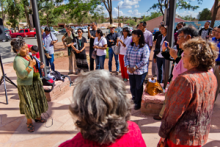Pressured to cooperate with the U.S. federal government in order retain at least some vestige of recognition as a sovereign nation, the Navajo Nation transitioned from traditional governance to a representative system in 1922. Under the paternalistic guidance of the U.S. Secretary of the Interior, the Navajo Business Council was created to negotiate mineral releases on tribal lands. In 1934 they disbanded after refusing to adopt the Indian Reorganization Act, only to reform under a new name, Navajo Nation Council, in 1937. The Navajo Tribal Council is presided over by a council-elected speaker and includes 24 elected members from 110 tribal chapters. The Navajo Tribal Council meets at Window Rock, Arizona at least four times a year, when they discuss new legislation for and issues on the Navajo Nation Reservation.
"Navajo Council delegate Katherine Benally speaking to her constituency, July 5, 2012" by Donovan Shortey.
A01 The Blessing Way (01-07) p. 29
A01 The Blessing Way (01-07) p. 59
A01 The Blessing Way (01-07) p. 97
A01 The Blessing Way (01-07) p. 119
A05 Listening Woman (02-13) p. 35
A05 Listening Woman (02-13) p. 46
A05 Listening Woman (02-13) p. 66
Ewen, Alexander and Jeffrey Wollock
2014 Indian Reorganization Act. Encyclopedia of the American Indian in the Twentieth
Century. New York: Facts On File, Inc.
Kessel, William B., and Robert Wooster
2005 Dawes Severalty Act. Encyclopedia of Native American Wars and Warfare. New York:
Facts On File, Inc.
Navajo Election Administratoin
N.d. Chapter History. http://www.navajoelections.navajo-nsn.gov/chapter_history.html,
accessed August 28, 2014.

